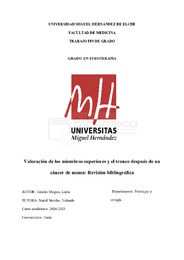Por favor, use este identificador para citar o enlazar este ítem:
https://hdl.handle.net/11000/37494Registro completo de metadatos
| Campo DC | Valor | Lengua/Idioma |
|---|---|---|
| dc.contributor.advisor | Nadal Nicolás, Yolanda | - |
| dc.contributor.author | Catalán Megías, Lucía | - |
| dc.contributor.other | Departamentos de la UMH::Patología y Cirugía | es_ES |
| dc.date.accessioned | 2025-09-24T07:33:55Z | - |
| dc.date.available | 2025-09-24T07:33:55Z | - |
| dc.date.created | 2025-05-16 | - |
| dc.identifier.uri | https://hdl.handle.net/11000/37494 | - |
| dc.description.abstract | Introducción: El número de pacientes con cáncer de mama ha incrementado en los últimos años y los tratamientos pueden dejar secuelas como limitación del rango, dolor, aparición del síndrome de membrana axilar e incluso tener efectos secundarios psicológicos. Es por ello que el papel de la fisioterapia es fundamental para valorar a los pacientes y darles un tratamiento adecuado. Objetivos: Valorar el estado en el que se encuentran los miembros superiores y el tronco en personas con cáncer de mama y determinar la efectividad de la fisioterapia en su recuperación. Material y métodos: Se realizó una búsqueda bibliográfica de artículos publicados en los últimos 10 años en las bases de datos PubMed, Scopus, The Cochrane Library y Embase. Resultados: Se obtuvieron un total de 13 artículos para su análisis en la revisión bibliográfica. Donde se vio que la fisioterapia ayuda en las secuelas y complicaciones que pueden surgir en el miembro superior tras el tratamiento médico del cáncer. Conclusión: La fisioterapia ha demostrado ser eficaz en el tratamiento de complicaciones tras el cáncer de mama, como son el dolor, limitación del rango de movimiento y aparición del síndrome de la membrana axilar. Además ayuda además a aumentar la calidad de vida de los pacientes. | es_ES |
| dc.description.abstract | Introduction: The number of patients with breast cancer has increased in recent years, and treatments can leave sequelae such as limited range of motion, pain, the appearance of axillary web syndrome, and even psychological side effects. This is why the role of physiotherapy is fundamental for assessing patients and providing appropriate treatment. Objectives: To evaluate the state of the upper limbs and trunk in people with breast cancer and determine the effectiveness of physiotherapy in their recovery. Material and methods: A bibliographic search was conducted for articles published in the last 10 years in the PubMed, Scopus, The Cochrane Library, and Embase databases. Results: A total of 13 articles were obtained for analysis in the literature review. It was found that physical therapy helps with the after-effects and complications that can arise in the upper limb after medical cancer treatment. Conclusion: Physical therapy has proven effective in treating complications after breast cancer, such as pain, limited range of motion and the development of axillary web syndrome . Also help to improve patients’ quiality of live. | es_ES |
| dc.format | application/pdf | es_ES |
| dc.format.extent | 29 | es_ES |
| dc.language.iso | spa | es_ES |
| dc.publisher | Universidad Miguel Hernández | es_ES |
| dc.rights | info:eu-repo/semantics/openAccess | es_ES |
| dc.rights | Attribution-NonCommercial-NoDerivatives 4.0 Internacional | * |
| dc.rights.uri | http://creativecommons.org/licenses/by-nc-nd/4.0/ | * |
| dc.subject | cirugia de cáncer de mama | es_ES |
| dc.subject | mastectomia | es_ES |
| dc.subject | función | es_ES |
| dc.subject | miembro superior | es_ES |
| dc.subject.other | CDU::6 - Ciencias aplicadas | es_ES |
| dc.title | Valoración de los miembros superiores y el tronco después de un cáncer de mama: Revisión bibliográfica | es_ES |
| dc.type | info:eu-repo/semantics/bachelorThesis | es_ES |

Ver/Abrir:
TFG CATALÁN MEGIAS, LUCÍA.pdf
1,05 MB
Adobe PDF
Compartir:
 La licencia se describe como: Atribución-NonComercial-NoDerivada 4.0 Internacional.
La licencia se describe como: Atribución-NonComercial-NoDerivada 4.0 Internacional.
.png)